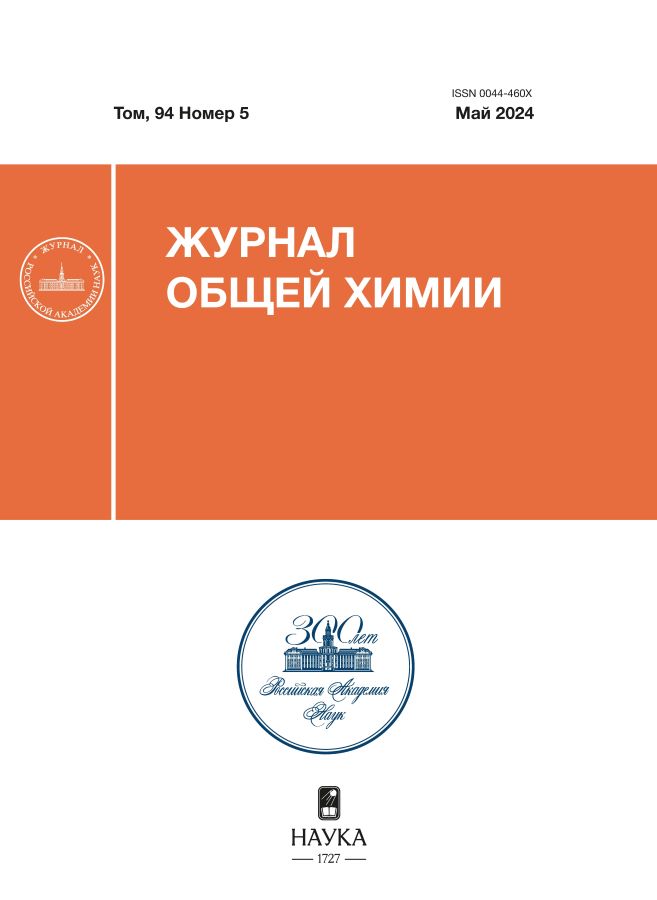Synthesis of phosphinic structural analogue of Met-Glu-His-Phe
- Autores: Shevchenko V.P.1, Borodachev А.V.2, Dmitriev М.E.2, Shevchenko К.V.1, Kalashnikova I.P.2, Ivanov А.N.3, Nagaev I.Y.1, Ragulin V.V.2, Myasoedov N.F.1
-
Afiliações:
- National Research Centre “Kurchatov Institute”
- Federal Research Center of Problems of Chemical Physics and Medicinal Chemistry of the Russian Academy of Sciences
- University “Synergy”
- Edição: Volume 94, Nº 5 (2024)
- Páginas: 608-618
- Seção: Articles
- URL: https://transsyst.ru/0044-460X/article/view/667404
- DOI: https://doi.org/10.31857/S0044460X24050087
- EDN: https://elibrary.ru/FJXPXF
- ID: 667404
Citar
Texto integral
Resumo
The synthesis of a phosphinic structural analogue of the tetrapeptide Met-Glu-γ-His-Phe by adding the dipeptide component His-Phe to the adamantyl ester of the phosphinic pseudo-Met-[P]-Glu-peptide in the form of cyclic glutamate anhydride is proposed. The conditions for the interaction of phosphinic pseudo-Met-[P]-Glu-anhydride with His-Phe in free form to form phosphinic Met-[P]-Glu-γ-His-Phe tetrapeptide have been found. A chromatographic mass-spectrometry study, including MS2, and NMR of the phosphinic tetrapeptide on 1H, 13C, 31P nuclei was carried out using the methods of two-dimensional 1H–1H COSY, 1H–13C HSQC and 1H–13C HMBC NMR spectroscopy.
Texto integral
Sobre autores
V. Shevchenko
National Research Centre “Kurchatov Institute”
Autor responsável pela correspondência
Email: rvalery@dio.ru
Rússia, Moscow
А. Borodachev
Federal Research Center of Problems of Chemical Physics and Medicinal Chemistry of the Russian Academy of Sciences
Email: rvalery@dio.ru
Institute of Physiologically Active Compounds
Rússia, Chernogolovka, MoscowМ. Dmitriev
Federal Research Center of Problems of Chemical Physics and Medicinal Chemistry of the Russian Academy of Sciences
Email: rvalery@dio.ru
Institute of Physiologically Active Compounds
Rússia, Chernogolovka, MoscowК. Shevchenko
National Research Centre “Kurchatov Institute”
Email: rvalery@dio.ru
Rússia, Moscow
I. Kalashnikova
Federal Research Center of Problems of Chemical Physics and Medicinal Chemistry of the Russian Academy of Sciences
Email: rvalery@dio.ru
Institute of Physiologically Active Compounds
Rússia, Chernogolovka, MoscowА. Ivanov
University “Synergy”
Email: rvalery@dio.ru
Rússia, Moscow
I. Nagaev
National Research Centre “Kurchatov Institute”
Email: rvalery@dio.ru
Rússia, Moscow
V. Ragulin
Federal Research Center of Problems of Chemical Physics and Medicinal Chemistry of the Russian Academy of Sciences
Email: rvalery@dio.ru
Institute of Physiologically Active Compounds
Rússia, Chernogolovka, MoscowN. Myasoedov
National Research Centre “Kurchatov Institute”
Email: rvalery@dio.ru
Rússia, Moscow
Bibliografia
- Пономарева-Степная М.А., Бахарев В.Д., Незавибатько В.Н., Андреева Л.А., Алфеева Л.Ю., Потаман В.Н. // Хим.-фарм. ж. 1986. Т. 20. № 6. С. 667.
- Пономарева-Степная М.А., Незавибатько В.Н., Антонова Л.В., Андреева Л.А., Алфеева Л.Ю., Потаман В.Н., Каменский А.А., Ашмарин И.П. // Хим.-фарм.ж. 1984. Т. 18. № 7. С. 790.
- Ашмарин И.П., Незавибатько В.Н., Мясоедов Н.Ф., Каменский А.А., Гривенников И.А., Пономарева-Степная М.A., Андреева Л.А., Каплан А.Я., Кошелев В.Б., Рясина Т.В. // Журнал высшей нервной деятельности им. И.П. Павлова. 1997. Т. 47. № 2. С. 420.
- Amino Y., Nakazawa M., Kaneko M., Miyaki T., Miyamura N., Maruyama Y., Eto Y. // Chem. Pharm. Bull. 2016. Vol. 64. N 8. P. 1181. doi: 10.1248/cpb.c16-00293
- Государственный реестр лекарственных средств. М.: Медицинский совет, 2009. Т. 2. Ч. 1, 2.
- Collinsova M., Jiracek J. // Curr. Med. Chem. 2000. Vol. 7. N 6. P. 629. doi: 10.2174/0929867003374831
- Mucha A. // Molecules. 2012. Vol. 17. N 11. P. 13530. doi: 10.3390/molecules171113530
- Georgiadis D., Dive V. // Top. Curr. Chem. 2015.Vol. 360. P. 1. doi: 10.1007/128_2014_571
- Zinc Metalloproteases in Health and Disease / Ed. N.M. Hooper. London: Taylor and Francis, 1996. P. 153.
- Hori M., Nishida K. // Cardiovasc. Res. 2009. Vol. 81. N 3. P. 457. doi: 10.1093/cvr/cvn3359
- Whittaker M., Ayscough A. // Celltransmissions. 2001.Vol. 17. N 1. P. 3.
- Pirad B., Matter H. // J. Med. Chem. 2006. Vol. 49.N 1. P. 51. doi: 10.1021/jm050363f
- Vinyukov A.V., Dmitriev M.E., Andreeva L.A., Ustyugov A.A., Shevchenko V.P., Sidoruk K.N., Lednev B.V., Freyman V.M., Dobrovolskiy Y.A., Ragulin V.V., Myasoedov N.F. // Biochem. Biophys. Res. Commun. 2021. Vol. 539. P. 15. doi: 10.1016/j.bbrc.2020.12.087
- Дмитриев М.Э., Шевченко К.В., Шевченко В.П., Нагаев И.Ю., Калашникова И.П., Рагулин В.В., Мясоедов Н.Ф. // ЖОХ. 2023. Т. 93. № 8. С. 1253. doi: 10.31857/S0044460X23080103; Dmitriev M.E., Shevchenko K.V., Shevchenko V.P., Nagaev I.Yu., Kalashnikova I.P., Ragulin V.V., Myasoedov N.F. // Russ. J. Gen. Chem. 2023. Vol. 93. N 8. P. 2022. doi: 10.1134/S1070363223080108
- Дмитриев М.Э., Винюков А.В., Рагулин В.В., Мясоедов Н.Ф. // ЖОХ. 2015. Т. 85. Вып. 9. С. 1576; Dmitriev M.E., Vinyukov A.V., Ragulin V.V., Myasoedov N.F. // Russ. J. Gen. Chem. 2015. Vol. 85. N 9. P. 2215. doi: 10.1134/S1070363215090315
- Dmitriev M.E., Ragulin V.V. // Tetrahedron Lett. 2010. Vol. 51. N. 19. P. 2613. doi: 10.1016/j.tetlet.2010.03.02013.
- Dmitriev M.E., Ragulin V.V. // Tetrahedron Lett. 2012. Vol. 53. N. 13. P. 1634. doi: 10.1016/j.tetlet.2012.01.09414.
- Dmitriev M.E., Golovash S.R., Borodachev A.V., Ragulin V.V. // J. Org. Chem. 2021. Vol. 86. N 1. P. 593. doi: 10.1021/acs.joc.0c02259
Arquivos suplementares

























